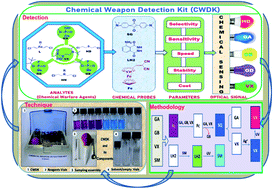Design and development of a prototype for specific naked-eye detection of blister and nerve agents†
Abstract
In view of the strong need to strengthen the national security arising from chemical terrorism, a rapid, specific, and onsite detection of chemical warfare agents (CWAs) employing a simple and easy-to-use kit is of utmost importance. Constant and sincere efforts are being carried out by the scientific community to find reliable techniques/methods for early warning detection. Herein, we designed a prototype technique in the form of a smart and portable chemical weapon detection kit (CWDK) to facilitate rapid and onsite detection. In this portable kit, a range of unique chemical probes were condensed to achieve the specific chromogenic and fluorogenic detection and discrimination of each member of blister and nerve agents. The embodiment of three chemical probes (Fc, SQ, and LH2) was eventually employed in a compact and flexible plastic packaging for detecting the presence of CWAs with the ‘naked-eye’ in the areas where laboratory services do not normally exist. The CWDK contains dye/reagent vials, sampling assembly, and a UV torch. The convenience and practicality of this technique suggest a great prospect for highly specific sensing of the complete class of CWAs with fast and accurate results in real-time scenarios with a sensitivity much below their lethal dose.



 Please wait while we load your content...
Please wait while we load your content...